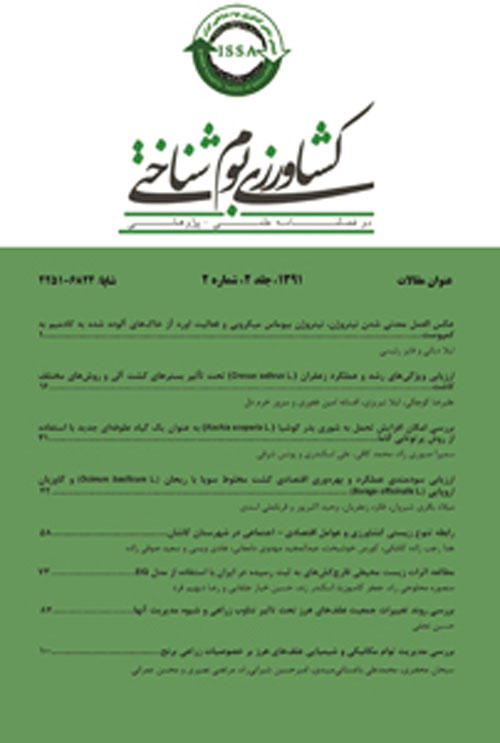Evaluation of irrigation intervals of growth stages on the morphophysiological properties of rice genotypes in the climate of Khuzestan, Iran
Author(s):
Article Type:
Research/Original Article (دارای رتبه معتبر)
Abstract:
Introduction
Rice can be irrigated like wheat and corn as an aerobic plant (Limouchi et al., 2015; Wu et al., 2011). A severe decrease in available water for multi-day irrigation intervals lead to negative effects on the plant and will reduce vegetative growth, particularly in the seedling stage (Salehifar et al., 2014). Supplemental irrigation can present a manageable alternative to reduce the negative aspects of the terminal drought (end of season) at the reproductive stage (Nehbandani et al., 2016). This research aims to study the effects of irrigation intervals on the growth steps of indices of stem dry weight, leaf dry weight and final grain yield of aerobic rice genotypes. One goal is to identify a physiological response of resistance mechanism or sensitivity to low water and waterlogging by studying changes in the mentioned traits. The other goal is to identify the positive role during vegetative growth that is played to increase grain yield as well as to provide functional traits to breed rice genotypes.
Material and methods
This study aims to examine the effects of different irrigation intervals on the physiological characteristics in the examined rice genotypes with a split-plot arrangement using a randomized complete block design with three replications in 2014 and 2015 in the Agricultural Research and Education Center of Shavar related to agricultural research and the Office of Natural Resources of Khuzestan. Experimental research includes four different irrigation intervals (1, 3, 5 and 7 days), and 12 genotypes of rice that were located in the main plots and sub-plots.
Results and disscussion
The combined analysis results illustrate that between genotype, irrigation protocol and the interaction of two factors there was a significant difference at the level of one percent at all stages of growth properties. The second irrigation protocol also accounted for the highest performance. IR 81025-B-327-3 genotype having the average of 6555.10 kg per hectare had the highest average grain yield. The highest amount of stem weight was obtained in two irrigation treatments with a frequency of once a day and once every three days. Its decrease could be due to its role in retransmission thereby leading to an increase in grain yield, as it has the biggest positive and significant correlation (0.382**) with the leaf weight yield versus stem weight. The highest amount in all growth stages were the irrigation intervals of five and seven days, which according to the positive and significant correlation between the two aforementioned attributes is reasonable.
Conclusion
The traits were all at their highest levels at the ending and critical stages of growth in irrigation intervals of 3 days. Due to the fact that the most highly positive and significant correlation was obtained at the ending stage of growth, we can explain the increase in performance particularly in this irrigation protocol. This consistency was also obtained with the genotype in a way that due to higher consistency at the final growth stage, genotypes with a higher resistance could perform better, even though at the early stages of growth due to rising costs of resistance, these traits were of less value. In general, the genotypes with the highest and lowest values of the studied traits at the late stages of development produced the highest and the lowest yield respectively. Judging by these results, it seems that by concentrating modifying purposes on increasing these traits we can hope grain yield increases.Keywords:
Language:
Persian
Published:
Journal of Agroecology, Volume:9 Issue: 1, 2019
Pages:
52 to 68
magiran.com/p1976464
دانلود و مطالعه متن این مقاله با یکی از روشهای زیر امکان پذیر است:
اشتراک شخصی
با عضویت و پرداخت آنلاین حق اشتراک یکساله به مبلغ 1,390,000ريال میتوانید 70 عنوان مطلب دانلود کنید!
اشتراک سازمانی
به کتابخانه دانشگاه یا محل کار خود پیشنهاد کنید تا اشتراک سازمانی این پایگاه را برای دسترسی نامحدود همه کاربران به متن مطالب تهیه نمایند!
توجه!
- حق عضویت دریافتی صرف حمایت از نشریات عضو و نگهداری، تکمیل و توسعه مگیران میشود.
- پرداخت حق اشتراک و دانلود مقالات اجازه بازنشر آن در سایر رسانههای چاپی و دیجیتال را به کاربر نمیدهد.
In order to view content subscription is required
Personal subscription
Subscribe magiran.com for 70 € euros via PayPal and download 70 articles during a year.
Organization subscription
Please contact us to subscribe your university or library for unlimited access!


